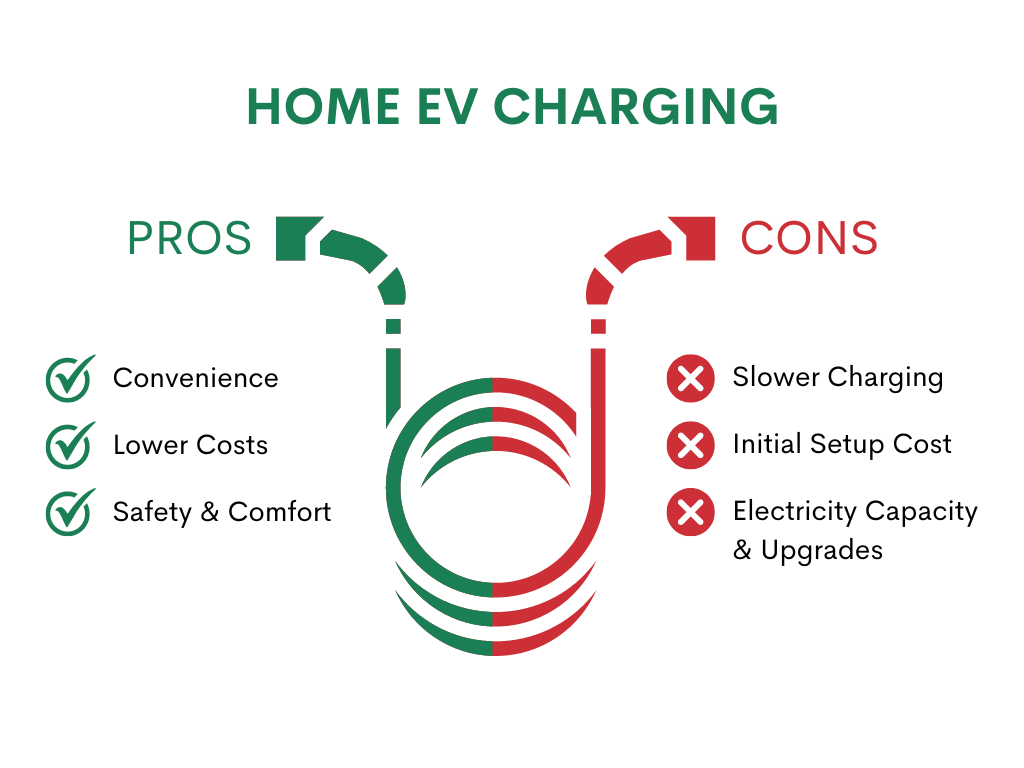Charging an electric vehicle (EV) can be done either at home or at public charging stations, each with its own set of pros and cons. Understanding these can help you make the most of your EV experience.


EV charging from home #
Pros #
- Convenience: The ability to charge your vehicle at home means you can wake up every day with a full charge, much like charging your smartphone overnight.
- Lower Costs: Electricity rates at home are typically lower than rates at public charging stations, especially if you charge your EV during off-peak hours.
- Safety and Comfort: Charging at home is done in the safety and comfort of your own property.
Cons #
- Slower Charging: Home charging, especially if using a standard 120V outlet (Level 1 charging), is slower than public charging stations. Upgrading to a 240V outlet (Level 2 charging) increases speed but requires an initial investment.
- Initial Setup Cost: Installing a home charging station (especially Level 2 chargers) can be costly, depending on your home’s current electrical capacity and the type of charging station.
- Electricity Capacity and Upgrades: Older homes may need electrical system upgrades to support the additional load of an EV charger, which can be costly and require a professional electrician’s services.
What You Need to Know About Home Charging #
- Most EV owners do the bulk of their charging at home.
- Level 1 charging uses a standard household outlet but is slow, often taking overnight to provide a significant charge.
- Level 2 charging is faster and more efficient but may require professional installation and a home electrical system check.
- You may be eligible for government or utility rebates and incentives to offset installation costs.
EV charging in public #
Pros #
- Faster Charging: Many public stations offer Level 2 and DC Fast Charging (Level 3), significantly reducing charging time.
- Accessibility: Public charging stations are becoming more widespread, providing more options for charging on the go.
- Enables Long-Distance Travel: With the expansion of public charging networks, it’s easier to use EVs for longer trips.
Cons #
- Higher Costs: Public charging, especially DC Fast Charging, can be more expensive than home charging due to higher rates and service fees.
- Inconvenience: While growing, the network of public charging stations may not always be conveniently located or might be occupied when you need them.
- Inconsistent Pricing and Payment Systems: Public charging infrastructure is operated by various companies, each with its own pricing structures and payment systems. This inconsistency can be confusing and sometimes requires users to have multiple memberships or apps
What You Need to Know About Public Charging #
- Public charging stations come in different types: Level 2 and DC Fast Charging. The latter is much faster but more expensive.
- Apps and maps are available to help locate charging stations, provide availability status, and sometimes allow reservation.
- Charges at public stations are either by the hour, by kWh, or a flat rate, depending on the network or station owner.
- Consider getting memberships or subscriptions to charging networks for better rates and easier access.
EV charger Map: Web App (eondrive.co.uk)




